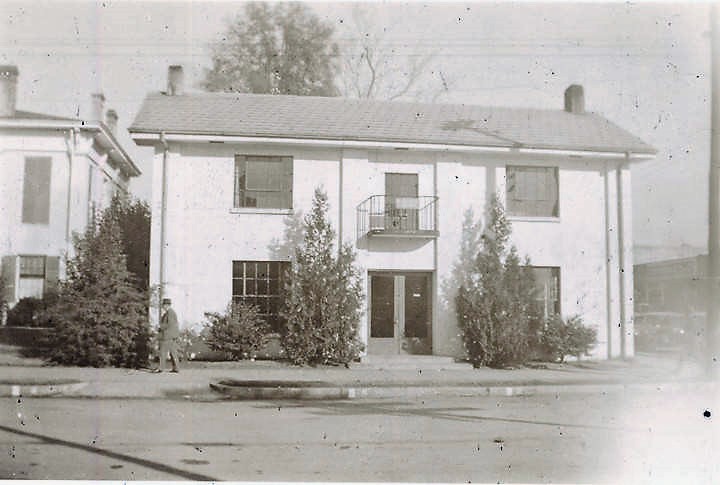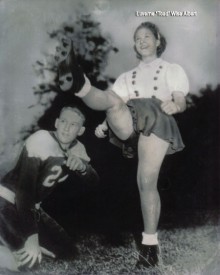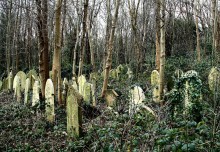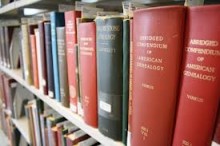THE HISTORY OF THE GREENE COUNTY LIBRARY
By Emory Peebles Hildreth
(Transcribed from The Alabama Historical Quarterly, Vol. 05, No. 04, Winter Issue 1943)
As librarian of the Greene County Library during its thirteen and a half years of existance, I think maybe I should write a brief history of-the library, before my memory and library scrap books fail me.
Gala Opening
My most vivid memory of the library is the day of its gala opening, June 20, 1930. Eutaw was ninety years old and this was its first public library. No wonder the opening was impressive. The two witness and jury rooms on the second floor of the beautiful old court house was the first location of the library. Judge L. H. Montgomery had had the two rooms and the hall between freshly plastered and the floors painted. The enormous windows were raised and the library rooms were cool and attractive. An iron stairway had been erected on the outside of the court house connecting with the iron balcony just outside the library rooms. Beautiful oil paintings by Virginia W. Barnes, Eutaw’s artist, adorned the walls. Vases of lovely summer flowers added color, and Mrs. M. B. Cameron’s canary birds furnished music. The library executive committee formed the reception committee and beautiful young girls served punch to one hundred and twenty who visited the library. Everyone was enthusiastic over the young library and showered the library with books, one hundred and forty in all. Sixty-three books were borrowed that first afternoon.
Library caught fire
Another vivid memory is the time the library caught fire in Jan., 1931, and broke up Eutaw’s famous domino game. I went to the library at three o’clock that afternoon, as usual, and when I opened the door to the room where the juvenile books were kept, dense smoke gushed out into the hall, “I rushed down the steep iron steps from the balcony, ran into the room in the court house where the more or less continuous domino game was in session and told the players and spectators that the library was on fire. Old men and young men found buckets from somewhere, filled them with water and ran up to the library. They put the fire out in a short while, but the room was filled with smoke. With a new sensation of horror, I suddenly remembered that the Alabama Art League exhibit was on display in that smoke filled room. Glancing up at the handsome oil painting of a haughty lady in white evening dress, I thought: “Madam, you will never know how near you came losing your life.” It seemed like the irony of fate that an art exhibit that had been to the Magic City should have to eather a little extra smoke in beautiful, smoke-free Eutaw. It c> . probably helped eliminate some of the too new appearance of the oils. I didn’t know what to regret the most, the smoke on. the walls; the books and the visiting art exhibit, or having broken up the domino game.
Opened June 1930
The history of the library dates back two years before its opening in June 1930. Most probably I shouldn’t record the following item in its history, but surely I can state with pardonable pride that it was upon my suggestion, as president of the newly organized Arts Club, that in November, 1927, the Arts Club voted, unanimously, to foster the establishment of a public library in Eutaw. The motion was made by Mrs. R. E. Fulton and seconded by Mrs. R. H. (Virginia W.) Barnes. I suppose that could be called the birth of the Greene County Library project. It was our idea that every organization in the county arid all the county and Eutaw officials be asked to cooperate. The clubs were to be asked to give an initial gift of $25.00 and $10.00 annually to the library. I recall how seriously we worked over the selection of the proper club women to present the plans for the library to the different organizations. To those women, Mrs. David K. Trotter and Mrs. R. H. Barnes, is due the praise for interesting and securing the cooperation of all the organization’s and officials of Greene County and Eutaw. Letters were written to some of the organizations. The seven organizations were: Arts Club, Twentieth Century Study Club, Twenty-Three Circle, Kiwanis Club, Boligee Study Club, Junior Arts Club, and the U.D.C. Later on the American Legion and the Legion Auxiliary and still later, the Home Demonstration Club and the Lions Club joined in the work, but at the present time, some of the above organizations, the Kiwanis, Junior Arts Club, Boligee Study Club, and the Legion Auxiliary have disbanded and the U.D.C. has had to drop the library from its budget, so we receive only fifty dollars annually from clubs.
Met at home of Mrs. R. H. Barnes
After securing the cooperation of all the organizations and public officials, three members from each club, together with Judge L. H. Montgomery and Eutaw’s mayor, E. F. Hildreth, met at the home of Mrs. R. H. Barnes and organized the Greene County Library Association. The following officers were elected: President, Mrs. R. H. Barnes; Vice-President, Mrs. W. J. Barnes; Secretary, E. F. Hildreth; Treasurer, Mrs. Fannie Winston Steele. At the second meeting of the Association; a constitution was adopted. The Library Association has met annually since its organization, at which meetings reports are read by the librarian and treasurer, and officers are elected, if necessary. The officers usually serve two years. All of the presidents of the Library Association have been fine, capable women who were keenly interested in the library. Their names, in the order of their administration, are: Mrs. R. H. Barnes, Mrs. Fannie W. Steele, Mrs. A. H. Appleton, Mrs. J. S. Coleman, Mrs. A. N. Grubbs, Mrs. S. D. Bayer, Mrs. J. S. Morris, Mrs. Joel McLemore, Jr. and Mrs. Ralph Banks. All of the other officers have also rendered outstanding service to the library. In the past, each year the president of the Library Association put on some project to raise additional funds for the library, but in 1939 Mrs. H. W .Brodnax made the splendid suggestion that we have an annual Library Day in the fall on which day money would be solicited all over the county for the library. This method of raising library funds has been used for five years now and has been very satisfactory. The collection usually amounts to about $100.00. This fall it amounted to $143.43. Women from each section of the county and Eutaw are called upon to solicit funds on Library Day, and they cooperate beautifully, gix years ago, Mrs. Roberta K. Borden put on a carnival for the benefit of the library and that was very successful, the net receipts being about $105.00. Everyone cooperated on that project. It was lots of fun but required much work from many. That is why the Library Day method of supplimenting library funds has been so satisfactory. It doesn’t over-work anyone-. Each fall Judge Montgomery and the County Commissioners give $100.00 to the library. Five Hundred dollars have been added to the original endowment fund of $2,000.00.
Anonymous friend gave $1000.00
People frequently ask me how we secured the money to begin our library. The first fourteen hundred ($1400.00) dollars were secured from organizations, individual donations and’ from the production of a play in which practically the whole town lent a helping hand in one way or another. We were ready to begin plans for opening the library on that meager amount when an anonymous friend offered to give the library one thousand dollars if the Library Association would raise an additional thousand dollars. The challenge was accepted and a very efficient committee of men, Mr. J. O. Banks, Mr. J. F. Aldridge and Mayor E. F. Hildreth, went “around the square” in Eutaw and in a very short time secured the additional thousand dollars. We were delighted to have $3400.00 for our library. An endowment fund was established with $2000.00 of this money, which, under the able management of Mr. J. O. Banks, yielded the library about one hundred dollars a year for eleven years. It is more now that the endowment fund has been increased. The County has always furnished the library rooms, janitor service and fuel, and the town of Eutaw has always paid the librarian’s salary which was $25.00 a month until the depression hit the town in 1932. The librarian’s salary was then reduced to $15.00 a month. The Library Association suppliments this salary with three dollars a month. The library is open two hours each day.
Difficulty finding librarian
While the library movement was steadily progressing toward realization back in the winter of 1930, we were having difficulty in finding a librarian. Many capable prospects were offered the position but none wanted it. At a meeting of the Library Executive Committee, when the problem of finding a librarian was under discussion, Mrs. Fannie W. Steele turned to me and asked me if I wouldn’t be librarian. On the impulse of the moment, I agreed to be librarian, temporarily, since we had to have a librarian immediately and I had once had a little library experience when I was assistant librarian at Alabama College one session. I thought I could spare two hours a day from my still thrilling housekeeping problems but that night I felt rather overwhelmed with my new responsibility and I wondered why I had agreed to be librarian. It seemed such a herculean undertaking for one who knew almost nothing about library science except checking books out and in, and mending them.
I decided it was “what is to be” that I should be Librarian, temporarily. Two years before, when I first came to Eutaw I had tried to maintain a small rental library in our home and failed. The people weren’t interested in paying to read books. Years before that, I had succeeded in establishing a five shelf library of classics for the English department in Highland Institution, a Mountain Mission at Guerrant, Kentucky, where I taught and years and years before that, while living in the now deserted village of Vienna, Alabama, I was summer librarian of the Cedar Grove Academy (one room school house) library, and faithfully cared for the four dozen or more books. I decided, the time had arrived for me to experiment further as a librarian.
Book orders
I had already been working on the first book order. There were three of us on the book committee, Mrs. Fannie W. Steele, Mrs. R. E. Fulton and myself. Mrs. Steele’s eyes were giving her trouble at that time and Mrs. Fulton was very busy with her duties as president of Tuscaloosa Presbyterial so the work fell upon me. I spent all of my spare time studying book catalogs. When I was a child, each Christmas night I would order books with the five dollars my uncle always gave me for Christmas. In those days, five dollars would buy more books than now but not near enough to suit me. I would wish that some day I could order all the books I wanted at one time . That wish was more than fulfilled in the spring of 1930 when I experienced the thrill of ordering seven hundred books at one time! The nucleus for the first order was the ten thousand dollar Harper prize list of the one hundred books that every library should have. In addition, the latest books of fiction, non-fiction/biography, juvenile books and second-hand sets of classics were ordered. The latter were ordered from Lary’s in Philadelphia and were very decorative volumes. Among them were: Shakespeare, Ruskin, Balzac, Thackeray, Scott, BulwerLytton, Dickens, George Elliott, Robert Burns, Stevenson, Kipling, Poe, Mark Twain, Hawthorne and others. I thought they would be read, but alas! Fortunately, at that time the State Department of Education was paying one-third of the cost of all books purchased by public libraries. Miss Alice Wyman, librarian at the University, had been very helpful in giving me names and addresses of book companies, magazine agencies and the name of a company who sold library supplies.
I shall never forget the huge undertaking of getting the seven hundred books ready to place on the new adjustable steel book shelves . A number of boy scouts, A. J. Hook, Reed Beeker, Charlie Coleman and Wikles Banks, Jr., volunteered to help me stamp the books and paste in the card pockets and date due slips. They were efficient and willing workers, sticking to the job until the last book was ready to be catalogued.
Books arrival
As soon as the books were ready, Mrs. G. W. Brock, librarian at the State College for Teachers at Livingston came to Eutaw on the invitation of Mrs. Fannie W. Steele, and gave the library a whole day’s work teaching me all I know about cataloging books and helping me catalog as many as possible. She brought with her one of her library assistants and all day they worked, stopping only long enough to have lunch with me. Their help was invaluable and the Library Association was deeply grateful to them. A few months later, Mrs. Brock returned and gave me some more » much needed lessons in library science.
During the two weeks following Mrs. Brock’s first visit, the Eutaw ladies helped me finish cataloging the books. The library was fortunate in having the court room for a work room. Books were spread out on benches and tables, and I taught the ladies the little I had learned about cataloging books. First the books had to be entered in the accession book, given a number, then a book card and three or more catalog cards had to be written for each book. The huge windows and the doors that opened onto the quaint iron balconies were wide open letting the balmy June air sweep through the sixty-four year old court room to refresh the ladies while they worked on and on. Their labor was a continuation of the beautiful spirit of interest and cooperation on the part of all the people of Greene County which had and has characterized the entire history of the Greene County Library.
News of library
Mr. J. S. Coleman, editor of the Greene County Democrat, has been very generous about giving space in his paper for all library publicity, which has meant much in the growth of the library. Each month the library circulation and other library news appears in the Democrat.
From the very beginning, boxes of library books were sent regularly to rural schools requesting them. Some adult books are put in the boxes and the children and grown people in the rural communities derive great pleasure from the books.
The serious objection to having the library in the witness and jury rooms of the courthouse, was that the library had to close during each session of Court. After Court, books would be found badly out of place and it would take days to get the library straight again. Being deprived of the library during court inconvenienced the people and so everyone was delighted when the library soon began to outgrow the court house rooms and the far-seeing executive committee of the Library Association called a mass meeting of leading men and women of Greene County to appear before the County Commissioners to request them to have a library building erected. The Commissioners agreed to do this and, fortunately, for the young library, the contract for the new buiclling was let just prior to the 1931 depression. Times were very bad while the building was being erected but everyone felt pleased and grateful when it was finished and the books had been moved into the spacious, attractive building on a corner .of the court house square.
New library
The new library was very attractively furnished. Two long reading tables, a large desk, two magazine racks and an encyclopedia stand had been made by the contractor who built the library The desk was a lovely reproduction of a four hundred dollar library desk. In addition, a swivel chair and eight nice cane bottom chairs were bought and the very nicest linoleum was put on the floor.
The new building inspired another grand opening reception on November 7, 1931, and for this occasion, a second Alabama Art League Exhibit was secured. I recall how jealous and outraged I felt when some people who came to the library opening were so interested in the art exhibit they didn’t even notice the new library building, the attractive new furniture nor the hundreds of books! Those receiving at the opening of the new library building were Mrs. Fannie W. Steele, beloved president of the Library Association, Mrs. R. J. Kendall, Miss Elizabeth Archibald, Mrs J. T. McLemore, Jr., Mrs. Lynn Dearman, Mr. J. O. Banks and Judge L, H. Montgomery. There were one hundred and ninety visitors. Refreshments were served upstairs in the welfare office, all sponsoring clubs assisting.
Innumerable friends have given single volumes to the library. Those who have given large numbers of volumes are: The late Mr. J. O. Banks, Miss Addie McLemore, Mrs. Julia Pimick, Mrs. Pauline Womack Wright, the late Mr. John Cook, the late Mr. S. D. Palmer, Mrs. W. D. Johnston, Mrs. J. F. Aldridge, Mrs. John Meriwether, the late Mrs. Amelia Legare and the U. D. C. Chapter.
Gifts to library
Two beautiful oil paintings were given to the library. One, a large painting of the court house was painted and presented by the late Mrs. Ruth Crawford Watson, the other, an oil painting of magnolia blossoms and foliage was painted by Mrs. A. N. Grubbs. Two other beautiful paintings that hang in the library are a water color picture of the lovely ante-bellum Presbyterian Church in Eutaw and an oil painting of the beautiful court house, both painted by Mrs. Virginia W. Barnes and presented by the County. Possibly the most interesting picture in the library is the pretty old print of the Eutaw Mesopotamia Female Seminary that Mr. and Mrs. Owen Meredith, Sr., of Tuscaloosa found, had framed and presented to the Greene County Library, They were reared in Greene County and were loyal and generous enough to want the people of Greene County to own the valuable old print. Many people who come to the library tell me about their ancestors who attended the Seminary long ago. When the print was made the Seminary was a mile from town on Mesopotamia Street. Years later it was moved into town and is now an apartment house. No one knows when the Seminary was established but Henry P. Hatfield was principal of it in 1855, just fifteen years after Eutaw was incorporated. There were two male academies in Eutaw also and a book store. It would be interesting if the library could secure prints of the male academies. One year, upon the request of the Twentieth Century Study Club, the library spent $7.00 of that club’s annual donation to purchase an available piece of music, “The Mesopotamia Waltz Mazurka”, composed by Miss Anne Hatfield and inscribed to her pupils of the Eutaw Mesopotamia Female Seminary in 1853. The print of the Seminary is on the back of the music and this has been framed and hung in the library. The music has been bound and placed in the iron safe in the library.
Another valueable gift presented the library was an iron safe, given by Mr. J. O. Banks. He wanted to be sure the Library Association constitution and minutes were kept in a fire proof place. Mr. Banks also gave the library a new card catalog cabinet. He was on the Library Association Executive Committee from the very beginning and was always interested in the library and its needs. He took great pride in the fact that the library was completely catalogued.
Space in library
The library has grown from the original seven hundred volumes to four thousand and the circulation averaged nine hundred a month until this war era stopped many people from reading. The library has always been able to buy the most popular new fiction and non-fiction and the very best juvenile books. The library subscribes to the following magazines: Time, Readers Digest, Good Housekeeping, Cosmopolitan, Child Life, Life, Better Homes & Gardens and the Open Road for Boys. The library has about one hundred of the International Mind Alcove books, presented by the Carnegie Endowment for International Peace. They are all splendid books about foreign nations and international problems. The library has the Encyclopedia Britannica, Owens’ four volume History of Alabama, the twenty-one volume History of Southern Literature and other fine reference books. There is a wide selection of books on most every subject.
A few months ago when we were badly in need of shelf space, rather than spend any of our library income on new shelves, I exiled to the top of the steel book shelves near the ceiling, practically all of the beautifully bound, seldom read, second-hand sets of classics we had bought in 1930. I felt very guilty and apologetic (to the authors) while arranging Thackeray, Ruskin, Balzac and others on that ceiling high space. Their colorful bindings, stretching in a straight row, added a decorative touch to the library, however, a mural decoration that reminded me of the human bone decoration I saw in the Capuchin monastery in Rome. Dead things could still be decorative. And yet, I read an article by Andre Maurois in 1940 in which he mentioned the books he hated to part with as he made preparations to depart for the front and among his most treasured was his set of this same Balzac that I had just exiled to the ceiling. Well, I can still get them down if anyone should call for them. I have a feeling that unread books appreciate being remembered and requested, especially those that once were so popular.
Influenced other libraries
The Greene County Library has many things to point to with pride. For instance, a minister from a neighboring county visited our library to do some reference reading and some people organizing a library in Choctaw County wrote to us for details about the organization of our library. A picture of the library was used on the front of the programs of the A.F.W.C. Fourth District Convention when it met in Eutaw in 1936. Miss Agnes Ellen Harris, Director of the District, was responsible for that honor. She appreciated the fact that the library was begun as a federated club project. In a letter inclosing a check for our Library Day collection/Mrs. Roberta K. Borden wrote us: “If my resources were commensurate with my appreciation, this check would be multiplied a thousand times, because our Library has contributed more to my happiness than I can ever express to you.” The Red Cross was invited to move into one end of the library when the chapter had to find a new location in 1943.
It is interesting to recall the part the Eutaw pastors played in establishing the library. Dr. R. E. Fulton, pastor of the Presbyterian Church, was chairman of the committee on organization and presented the constitution to the Library Association at the second meeting. He has held several offices in the Library Association and is always on the Executive Committee. He gave the library a beautiful copy’ of the Bible. Mr. A. B. Carlton, pastor of the Methodist Church, was the second secretary of the Library Association. The late Mr. S. D. Palmer, rector of the Episcopal Church, was always interested in the library. He made a drawer for the librarian’s first desk, an antique pulpit affair that answered every purpose until we could do-better, and he made some shelf steps for the library. He wrote an article for the Democrat soon after library opened in which he said: “Greene County Library has now come to physical birth and potential usefulness, a well proportioned, vigorous and promising literary infant. In an intangible way, it will be an asset to county and town, in increased community self-respect and the respect of our neighbors. It is a real and tangible asset for all book lovers and a great educational opportunity, a potential and not enforced benefit.” I wish Mr. Palmer could know that the library has grown to four thousand volumes and that the circulation for January, 1940, was twelve hundred. He would be very pleased.
The library is indeed fortunate in having public officials who appreciate the value of the library to the town and county. Mayor J. K. Smith and the town councilmen, Judge L. H. Montgomery and the County Commissioners have been very interested in the growth of the library and cooperative whenever their help was needed.
Service to library
When I temporarily accepted the position of librarian, I little thought that the end of thirteen and a half years would find me still worrying about over-clue books and the financial inability to supply some people’s insatiable demand for more and more new books. The pleasure of associating with good books and watching the young library grow, more than compensated for these worries. Two operations and the arrival of my little son gave me a prolonged absence from the library on three occasions during which time the library was capably managed by my assistant librarians, Miss Francis Horton and later Mrs. B. B. Barnes, Jr., I have had two other capable library assistants, Mrs. B. D. Palmer, Jr., and Mrs. H. W. Brodnax, who is the present assistant. For several years, with the N.Y.A. help, the library was open four hours a day. The efficient N.Y.A. girls who worked in the library were Misses Mary Effie Williams, Kathlene Hollingsworth and Pearl Wilson.
Statistics of library
Statistics are sometimes interesting, as well as informative, so I shall give a few. The library is now thirteen and a half years old and has 4000 books. Seven Hundred and fifty-three books have been discarded. Each sponsoring club has, during the thirteen years, contributed $155.00, which includes the initial gift of $25.00 to the library fund and ten dollars annually. The total library circulation for the thirteen and. a half years has been 149,055. The total juvenile circulation has been 73,000. There is something soul satisfying in knowing that little children and big children of Eutaw and Greene County have free access to lovely juvenile literature. As Mr. S. D. Palmer said in his article about the library thirteen years ago: “It is a real and tangible asset for all book lovers and a great educational opportunity, a potential and not enforced benefit.” The sponsoring clubs and officials have aided the education of Greene County citizens in the broadest sense of the word by helping to establish and maintain the Greene County Library.
Because the library is open only three mornings and three afternoons a week, two hours daily, it is inconvenient for school children to get books, so boxes of books are sent to each of the grammar school grades except the first grade and the teachers gladly circulate the books among their pupils. One month last spring the grammar school circulation of library books was 560. “If Mohammed won’t go to the mountain, the mountain will go to Mohammed.” The children read more since library books are sent to their school rooms. The High School children do not read as much now as they did a few years ago when the teachers required more parallel reading and book reports. Only a few of them get books from the library during the winter.
Anonymous donor revealed
In the early part of my history of the library, I mentioned the anonymous gift of $1000.00 to the library fund fourteen years ago. Surely it can be told now who it was who so generously aided in the establishment of the library. For a long time only one person knew who the donor was but six years ago, he accidentally let the information out to a few other people—and since it can’t really be called a secret now that a few people know it, I’m going to tell who it was. It was Mr. Ward Ingram who was living at New Town, near Eutaw, at that time. His charming wife was a member of the Arts Club and helped solicit funds for the library. She interested her husband in the library cause and he gave the $1000.00 to the library in memory of his sister who was burned to death that year. Such a beautiful memorial to his sister. His gift forms a part of the library’s $2500.00 endowment fund. The interest from his memorial gift has purchased $50.00 worth of books annually for the library; books that have brought happiness and information to the young and old, the lonely, the sick, the students and booklovers of Greene County. The Ingrams moved away before the library was but a few months old, but their departing memorial gift left “Foot prints on the sands of time. Foot prints that perhaps another, seeing (reading) may ^take heart again”. How much more enduring this living memorial than one made of marble.
Income
The free Public Library Service in Montgomery has meant a great deal to the Greene County Library. Last year we borrowed from the Public Library, Service 183 books, the value of which was $303.00. Mrs. Lois Rainer Greene, the librarian in charge of that service, is very capable and cooperative and sends us books whenever we request them. Of course, they lend us only the value in books at one time that we purchase annually for our library, but as books are returned, our account is credited with that amount and more books are sent us. Last year we purchased $154.64 worth of books, so that entitled us to borrow that value in books, but it could be borrowed over and over during the year. The total income for last year was $423.04. Subtracting the total expenditure of $333.25, including $96.00 for endowment fund, from the $423.04 left a balance of $89.79 on hand. New books were ordered about that time which used-up most of that balance. The assured income of $50.00 from five clubs and $117.00 income from the endowment fund, a total of $167.00, could not support the library, as its annual cost runs around $333.25. The annual gift from the county of $100.00 and the annual Library Day collection of about $100.00 makes it possible to maintain the library on its present standard of service. Of course, some years more books are bought than other years. This year the rebinding of many worn out b6oks at 60c each will be an added expense. We also plan to have some magazines bound.
At the last meeting of the Library Association, Mr. Ed Hood and Mr. W. C. Banks were elected trustees of the Library’s $2500.00 endowment fund.
The library lost two of its most devoted and loyal supporters in the passing of Mrs. Fannie Winston Steele and Mr. J. O. Banks. They were always interested and generous and most appreciative of every evidence of the growth of the young library. They are missed greatly, although the library has many other loyal supporters.
Innumerable visitors from other towns tell us that we have one of the best small town libraries in the state. Greene County is proud of the library, and the sponsoring clubs and the town and county officials should be proud that their tireless, cooperative efforts of fifteen years ago have resulted in an institution we can all point to with pride.
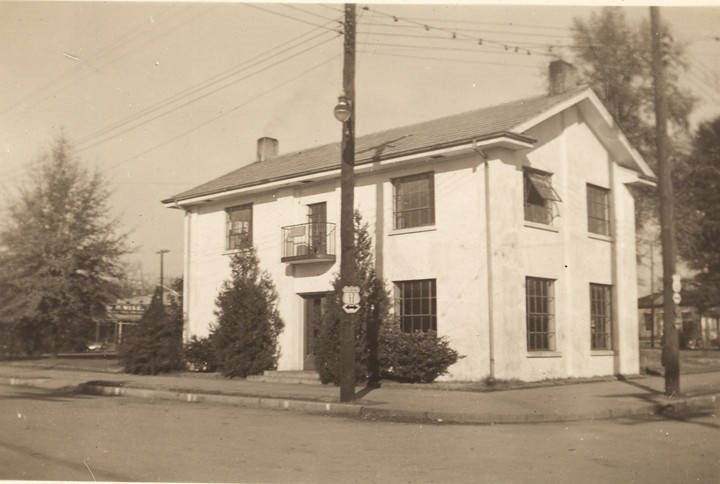
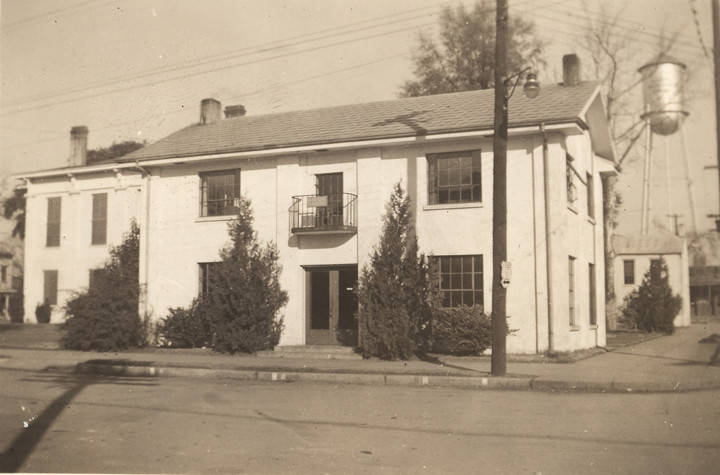
The first four Alabama Footprints books have been combined into one book, ALABAMA FOOTPRINTS – Volume I – IV: Four Volumes in One
1.ALABAMA FOOTPRINTS Exploration
2.ALABAMA FOOTPRINTS Settlement
3.ALABAMA FOOTPRINTS Pioneers
4.ALABAMA FOOTPRINTS Confrontation
From the time of the discovery of America restless, resolute, brave, and adventurous men and women crossed oceans and the wilderness in pursuit of their destiny. Many traveled to what would become the State of Alabama. They followed the Native American trails and their entrance into this area eventually pushed out the Native Americans. Over the years, many of their stories have been lost and/or forgotten. This book (four-books-in-one) reveals the stories published in volumes I-IV of the Alabama Footprints series.


